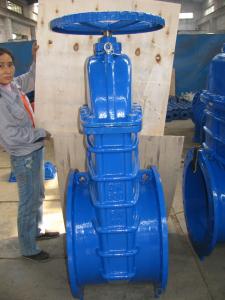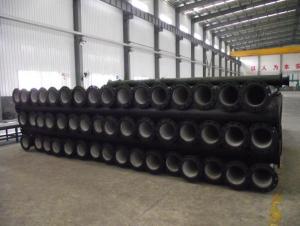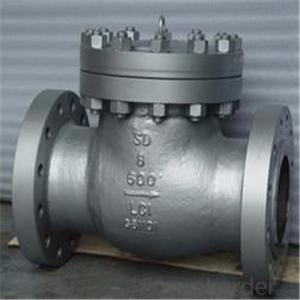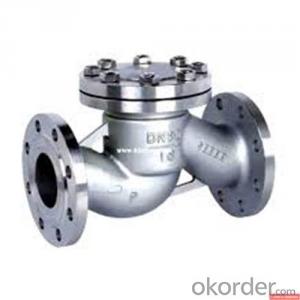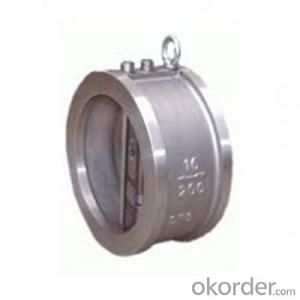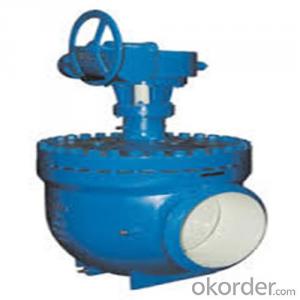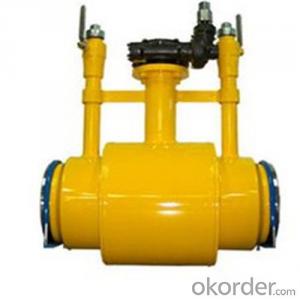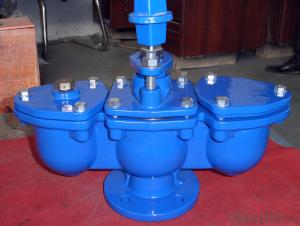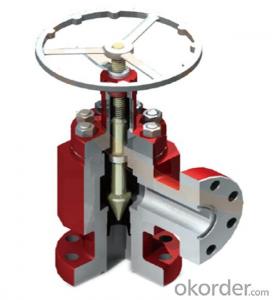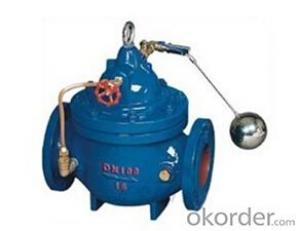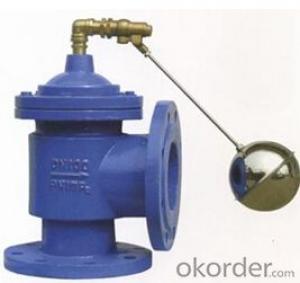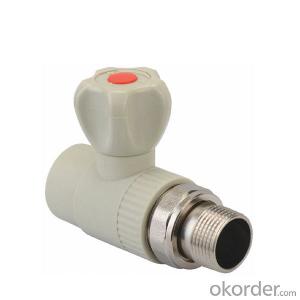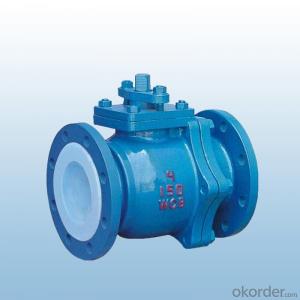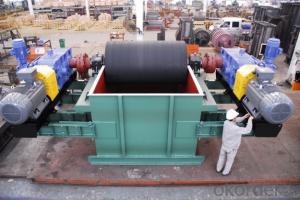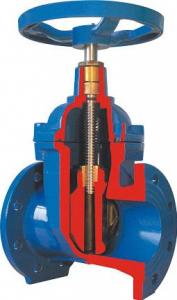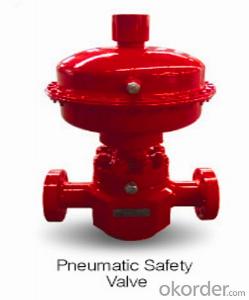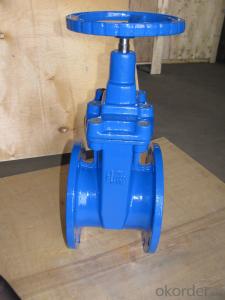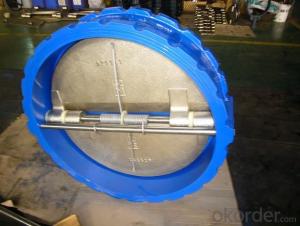Non-rising Stem Resilient Seated Gate Valve DN40-DN600
- Loading Port:
- China Main Port
- Payment Terms:
- TT OR LC
- Min Order Qty:
- -
- Supply Capability:
- -
OKorder Service Pledge
OKorder Financial Service
You Might Also Like
Type: | Non-Rising Stem |
Material: | Body: Cast Iron / Ductile Iron Wedge: Cast Iron / Ductile Iron Encapsulated with EPDM Seat: EPDM / NBR Shaft: SS410 Stem Nut: Brass O-ring: EPDM, NBR Wedge Nut: Brass / Bronze Hand Wheel: Ductile Iron
|
Operator: | Hand Wheel / Bevel Gearing / Square head / Electric actuator |
Face to Face: |
BS5163: 1986, DIN 3202 F4-F5, JIS B2002, ANSI B16.10
|
Flange: | BS4504, DIN 2532, JIS B2212, ANSI B16.10/ANSI B16.50
|
Working Pressure: | 16 Bar(200 PSI) |
Design and Manufacturer Standard : | BS5163, DIN 3352, JIS B2043 |
Test Standard: | API 598 BS6755 DIN 3230 JIS B2003 |
Application: | Water works, Sewage, Public facilties, Building industry, Petroleum, Chemical, Steel, Metallurgy, Paper Making Industry, Foods, Beverage, HVAC |
| | | | ||||||||
| | | | ||||||||
| | | | ||||||||
| | | | ||||||||
| | | | ||||||||
| | | | ||||||||
| | | | ||||||||
| | | | ||||||||
- Q:i disconnected the heater valve because it went bad, but when i removed it i forgot how it came off when i went to the auto parts store. i just need to know what way it should be facing and which hose goes where? can someone please help me?
- Heater control valve at heater core? If so the valve is horizontal with the vacuum motor on bottom, the vacuum port pointing towards rear of engine. The heater hoses for heater core are obvious, the hoses from the engine, the hose closest to the valve cover goes to the drivers side of the valve, the hose that wraps around from the front of the engine goes to the passenger side of the valve.
- Q:I took my 2nd valve out to wash it (i couldn't find my oil, but it worked fine) and I've tried making the number face the mouthpiece, yet it still is messed up and won't let me play a lot of notes.
- see if there is a slight protrusion on the valve. probably on a piece of plastic near or above the spring of the valve? that should fit in a notch in the trumpet valve tube. Just insert your valve partly in until the protrusion is resting on a ledge-like part. Then turn your valve around the tube gently until you hear a click when the notch goes in. You are right, the number on the valve usually faces the side where the mouthpiece is. Make sure your other valves are also placed in there correctly. If all else fails, ask the person who's teaching or taught you to play trumpet. or go to a trumpet store. Enjoy practicing!
- Q:The time has come to re shim my 06 450, and I am having a small problem (I think anyway). The exhaust valves have decreased to below the required spec and need to be replaced with thinner shims (as is usually the case), but the left intake valve has for some reason increased its valve clearance (from 0.16mm to 0.23mm). Is it normal for the valve clearance to increase? I thought they would only decrease... Any ideas? Unless the valve is being held open by something. Many thanks, Jim
- You want to do a clearance do you? Blow up the car.
- Q:How are they different from other valves ?
- Test valves are typically needle valves but I have seen some occasional usage of 1/4 to 1/2 inch globe valves and ball valves used as test valves for sampling. Pressure gauge installations may have test valves installed just below them. The valves are used to isolate the gauge from the system pressure, a second valve is used to vent the trapped pressure so the gauge could return to zero. The same vent valve could then be used to attach a calibrated pressure source to the pressure gauge so as to check (qualify) the gauge reading against the standard. This was done on select gauges where a quick in place qualification could be done without the need to physically remove the gauge from the gauge board. I have also seen test valve setups in systems using a three way valve in a setup to scavenge the sensing line with a clean fluid. This is done when dealing with a slurry which could block the sensing line suach as in a quick lime system. Clean water would flush the line before and after a reading so as to not trap material in the sensing line which could build up and block or cause a false reading. Test valve location also gives a handy mean to obtain a sample of the process fluid.
- Q:My mum (73, non-smoker, not overweight) has been diagnosed with 2nd degree aortic valve stenosis 5 years ago. Now deteriorating. Her cardiologist sees her every 6 months and strongly recommends surgery. She is too scared as dad died during a coronary bypass op. Any tips how to gently make her feel better about the op? She heard on the radio that some valve replacements can be done via catheter, not necessitating open heart surgery and heart-lung-bypass. Is that true for aortic valves and is it likely to become mainstream soon? She lives in Germany, so I guess good centres would be Munich, Wuerzburg and Heidelberg. Any views very appreciated!
- Unlike the mitral valve which can often be repaired, the aortic valve usually requires replacement. Once the decision is made to proceed with surgery, choices regarding the type of artificial valve (prosthesis) used should be considered. In broad terms there are two types of artificial valves or prostheses: mechanical valves and biological valves. A number of excellent mechanical replacement valves or prostheses are available today. Most surgeons have a particular preference for one valve over another related to technical factors (how they are sewn into place), however from the patient's point of view there is little if any difference between valves. The principle advantage of mechanical valves is their excellent durability. From a practical standpoint, they do not wear out. The principle disadvantage is that there is a tendency for blood to clot on all mechanical valves. Therefore patients with artificial valves must take anticoagulants or blood thinners for the rest of their life. There is also a small but definite risk of blood clots causing stroke. The decision on the type of valve used should be made in conjunction with your cardiothoracic surgeon and your cardiologist. Ultimately the choice will depend on a patient's preferences, lifestyle, and individual risks as determined by age and other medical conditions. I advice you to consult surgeryplanet, which is a global healthcare facilitator. They can give details about this surgery and the good centers for the surgery.
- Q:The valve on my radiator has numbers on it to determine the amount of air/steam leaving the heating system. what number should i put it on and how would i determine it
- I would think the easiest way would be to put a thermometer on the radiator (with the bulb in the air flow), turn the heat on to one setting and record the temperatures each half hour for about 4 hours. Then, turn the adjustment to a higher (or lower) number and repeat that. That way, you'd know which way to turn to set it. Of course, the level at which you'd be comfortable would be found by trying different settings. Assuming the adustment is a valve, valves in the USA will open by turning counter-clockwise. Closing is, of course, clockwise. Hope that helps. EDIT: I received your email - I don't mind at all! OK, so you have only one valve for all the radiators. Without knowing anything else, I'd say you just removed the part called the bonnet (the upper half of a valve). It shouldn't matter which number it's set on if it's reinstalled correctly. When a valve is removed, the best way to put back is to open it slightly (turn counterclockwise to a low number), then reinstall the bonnet. Once it's back in, it should work like normal. If that doesn't work, perhaps you can get a plumber or a local handyman to check it. As to the upper ones being airlocked, it really sounds like there is a blockage in the supply line. I am assuming this is steam-heat radiator that is supplied by a boiler-type heating unit?
- Q:does anyone have a bicuspid aortic valve and wrestle? my cardiologist told me that wrestling would put too much strain on my heart but i can feel that i'm fine when i wrestle so if you have a bicuspid aortic valve and wrestle or know anyone who has that disfunction and wrestles please let me know
- definite you will possibly have constantly had this, it fairly is a few thing you have been born with. a typical aortic valve is tricuspid, it fairly is it has 3 ultimate flaps, yet a bicuspid valve basically has 2 flaps. now and back those bicuspid valves supply no problems, yet in some people they could bring about heart murmur later in existence ( usually on your 30s or 40s ) via fact they permit a sprint blood to leak back the incorrect way while they are closed. If this gets intense sufficient, you are able to need surgical operation to in high-quality condition a man made valve. it fairly is exceedingly usual those days and not some thing to rigidity approximately.
- Q:my dad is going to go under heart valve replacement what are the chances of him surviving he is 58 years old and has copd
- It depends a lot on which valve and why it's being replaced, but unless the COPD is very bad, the average chance that a 58yo man who does not have any other major medical problems will survive single-valve replacement surgery is better than 98% if the surgery is done by an experienced surgeon at a good hospital. The COPD will very likely mean that his post-operative recovery will be prolonged and difficult, but he should do fine.
- Q:Recently, my best friend told me that he has tricuspid valve disease. So basically, the tricuspid valve in his heart is leaky and doesn't close tightly, allowing the blood to flow backwards.I just have a few questions about it and i don't wanna ask him because he doesn't like talking about his condition and i don't wanna make him uncomfortable. I just wanna know, is there any risk on his life or will he be able to live his life normally?Also, he doesn't take good care of himself at all. He completely ignores his condition. So i need to know, what should he avoid doing? Maybe I can prevent him from doing all the things that could hurt him. Most of all, i wanna know if there is anything I can do to help him.Guys if there's anything you can tell me, then please do. He's like my brother, we've been best friends since 1st grade and now we're both 16. I just want him to be okay.
- Any sort of valve surgical technique includes exposing the aorta of the midsection, hence it rather is one among those open heart surgical technique. over the years, this has replace right into a incredibly simple technique for heart medical doctors and it has a fulfillment fee of in simple terms approximately 80-ninety 5%. there is an threat which you may choose yet another surgical technique afterwards, yet that purely happens in approximately 5-10% of sufferers that get the surgical technique. The survival fee for this operation is extremely extreme and purely 5-10% of sufferers adventure any undesirable outcomes throughout the surgical technique. This consists of an infection, stroke, allergic reaction, or bleeding. i'm going to keep you in my prayers Alex. maximum suitable of success to you!
- Q:behind the valve cover of the #1 and #2 cylinder there are 2 intake and 2 exhaust valves I need know (cylinder #1) which is the intake and which is the exhaust. thank you in advance.
- The intake valves are the two rocker arms in the center of the passenger-side head. The exhaust valves are the rocker arms on either end of the head. For the #1 cylinder, the exhaust valve is the one closest to the flywheel side of the engine, and the intake valve is the next one towards the rear of the car. For example, if you're underneath the car and looking at the head, this is the pattern: Ex #2, In #2, In #1, Ex #1.
1. Manufacturer Overview |
|
|---|---|
| Location | |
| Year Established | |
| Annual Output Value | |
| Main Markets | |
| Company Certifications | |
2. Manufacturer Certificates |
|
|---|---|
| a) Certification Name | |
| Range | |
| Reference | |
| Validity Period | |
3. Manufacturer Capability |
|
|---|---|
| a)Trade Capacity | |
| Nearest Port | |
| Export Percentage | |
| No.of Employees in Trade Department | |
| Language Spoken: | |
| b)Factory Information | |
| Factory Size: | |
| No. of Production Lines | |
| Contract Manufacturing | |
| Product Price Range | |
Send your message to us
Non-rising Stem Resilient Seated Gate Valve DN40-DN600
- Loading Port:
- China Main Port
- Payment Terms:
- TT OR LC
- Min Order Qty:
- -
- Supply Capability:
- -
OKorder Service Pledge
OKorder Financial Service
Similar products
New products
Hot products
Hot Searches
Related keywords
